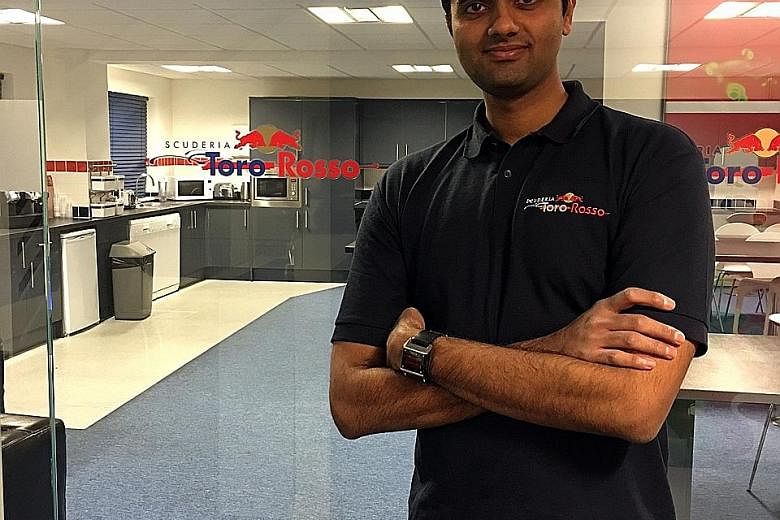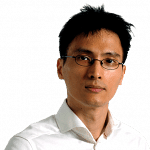It is not very often that you hear about a Formula One engineer playing the violin, but this is just what Gautham Ramesh does in his free time.
"Music has been an integral part of my life so far and it will always be," said the only Singaporean engineer working in the F1 industry, who played with the National University of Singapore's (NUS) Indian Instrumental Ensemble as a student.
"When I want to do maths, music helps me focus a bit more and remove distractions."
Ramesh, 29, is now based in Britain with Italian team Scuderia Toro Rosso's (STR) aerodynamics department.
He also has experience with three other F1 teams under his belt: Lotus, Marussia and Williams.
Ramesh is an expert in using an engineering method called computational fluid dynamics to model the air flow around an F1 car for achieving optimal performance.
For his work, he uses a cluster of computers that has the combined number-crunching power of about 600 personal desktops.
"Driving is an art, but now with so much information and data available, it has become an exact science as well," he said in a telephone interview from Oxford.
Working on the science and art of driving at STR are about 350 staff in total, but it is not a large number compared to bigger teams like Mercedes and Ferrari, who currently have about 1,000 staff each.
"The drivers occasionally do come around to the factory and discuss certain things with the engineers to help identify any issues or provide some feedback about how the car feels on track," said Ramesh.
He also recalled: "My favourite moment (in F1) so far has to be Romain Grosjean's third-place podium finish for Lotus in 2015 in the Belgian Grand Prix at Spa.
"The team and the race staff pulled off an immense effort and it was somewhat miraculous given the issues we were having financially at that time."
The engineer's lifelong love for automobiles had humble beginnings in toy cars, which his father gave him when he was young.
When he first saw an F1 grand prix on cable television while in his fifth year at Naval Base Primary School, he immediately got hooked. And it wasn't just a fleeting childhood dream.
He went on to read double mathematics at Yishun Junior College to equip himself with the capabilities to realise his dream.
At NUS, he was selected as a member of the university's Formula Society of Automotive Engineers (FSAE) race car team supervised by engineering professor Seah Kar Heng.
"He was able to exhibit his unique talent in engineering. His peers unanimously chose him to be their team leader," said Prof Seah.
In 2011, Ramesh led the NUS team to clinch a 23rd-place finish out of 120 in the FSAE international competition in Michigan, USA, upping the team's ranking by more than 30 notches over the previous year.
He reckons a major turning point was the masters thesis he did under the wings of Williams F1 at Imperial College London.
"It really opened up opportunities to the F1 world," he added.
"In NUS FSAE, you know everything about every single part of the car.
"In F1, a lot more people are working on a lot more areas of the car."
Ramesh also put F1 in a wider perspective, explaining that F1 and aeroplanes are the opposite of each other, as one aims to stay down while the other aims to stay up.
Noting another big difference, he said: "In F1, all the forces are acting through the four tyres of the car.
"What I love about F1 is the constant striving to make something better and the constant pressure there is to find performance to put on the car."
When away from the heat of competition, Ramesh enjoys running and cycling as well as the violin, far away from those immense forces and blistering speeds.
"It helps you relax when you're bogged down by a problem," he said.
After moving to Britain in 2011, Ramesh found more time to spend with his family. He is expecting his first child next month.
"This is one good thing living on this side of the world," he said, referring to the less hectic work culture there.
The enforced summer break in the F1 calendar in August each year also helps him to recharge.
Ramesh returned to NUS FSAE earlier this year to share his experiences and inspire his juniors.
Goh Wei Liang, one of the current NUS FSAE team members, said: "Gautham's sharing on ingenious methods to better visualise the car's aerodynamics have inspired me to keep pursuing the pinnacle of race car engineering in new and innovative ways."
Arvind Ram, another team member, added: "Gautham's story teaches us all that when opportunities don't exist, you make yourself one."
Ramesh's wife Charanya, 29, a doctor, gives him an added perspective on life.
He said, "She is always looking for things to enhance the lives of other people."


